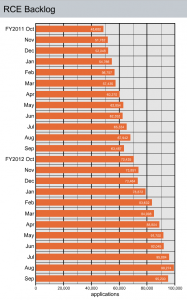Making the Decision to Appeal vs. Another RCE
 Knowing when to give up on a patent application is particularly important for any patent applicant, but when is enough really enough? When should a patent practitioners advise the client to either walk away or file an appeal? Financial resources are limited even for the largest corporations, and throwing good money after bad is not a strategy for success, or a recipe for keeping your clients happy.
Knowing when to give up on a patent application is particularly important for any patent applicant, but when is enough really enough? When should a patent practitioners advise the client to either walk away or file an appeal? Financial resources are limited even for the largest corporations, and throwing good money after bad is not a strategy for success, or a recipe for keeping your clients happy.
When you do not want to give up on a patent application, filing a request for continued examination (RCE) pursuant to 37 CFR 1.114 can be an attractive option compared with the cost and delay associated with filing an appeal to the Patent Trial and Appeal Board (PTAB). The filing of the first RCE for a small entity costs $600, and the cost of filing a second or subsequent RCE for a small entity costs $850. Those amounts are doubled for large entities. But filing an RCE also gives the applicant two more bites at the apple in order to try and convince the patent examiner to allow at least some claims. That is, of course, provided that the same rejection cannot be made in the RCE. If the same rejection could be made in the RCE, then the first action could be made final. Assuming you make a proper submission, which includes, but is not limited to, an information disclosure statement; an amendment to the written description, claims, or drawings; new arguments; or new evidence in support of patentability, you should get at least two additional office actions.
USPTO Update: After Final, Software and Sequestration
 Recently there has been some interesting news coming from the USPTO…and about the USPTO budget, courtesy of AIPLA taking up the fight against sequestration with the Office of Management and Budget (OMB). What follows is a synopsis of events over the past week.
Recently there has been some interesting news coming from the USPTO…and about the USPTO budget, courtesy of AIPLA taking up the fight against sequestration with the Office of Management and Budget (OMB). What follows is a synopsis of events over the past week.
Addressing the RCE Problem
Last week, the United States Patent and Trademark Office (USPTO) announced in the Federal Register that it would modify the After Final Consideration Pilot Program (AFCP) to create an After Final Consideration Pilot Program 2.0 (AFCP 2.0). The goal of AFCP 2.0 is much the same as it was when the USPTO initially introduced the precursor AFCP. According to the USPTO, the goal of AFCP 2.0 is to reduce pendency by reducing the number of RCEs and encouraging increased collaboration between the applicant and the examiner to effectively advance the prosecution of the application. Thus, this can and should be viewed as part of the USPTO effort to continue to try and address the RCE problem. (more…)
05.22.13 | patent eligibility, Patent Issues, posts, software patents | Gene Quinn
USPTO to Hold Roundtable Discussions on RCE Practice
 By: Gene Quinn (IPWatchdog.com)
By: Gene Quinn (IPWatchdog.com)
As you may be aware, there is a growing number of unexamined Requests for Continued Examination (RCEs) clogging the Patent Office docket. In fact, as of the end of Fiscal Year 2012, there were 95,200 RCEs that were awaiting examiner consideration, which is almost double the 48,680 that were awaiting examiner action at the start of Fiscal Year 2011.
The USPTO is concerned about the RCE backlog and the agency, in collaboration with the Patent Public Advisory Committee (PPAC), will host a series of public roundtables to solicit stakeholder input on ways the agency can reduce the number of Request for Continued Examination (RCE) filings.
The initiative is part of the USPTO’s effort to reduce patent application pendency. In order to accomplish this, the USPTO is seeking to better understand the root causes for filing RCEs and plans to use the information gathered during the public events to design additional programs and initiatives aimed at reducing RCE filings and backlog. (more…)
02.14.13 | Patent Prosecution, USPTO | Gene Quinn


No Comments
04.6.15 | Patent Issues, USPTO | Gene Quinn